May-June 2001
A Tale Of Courage
By Fr. Bernard Steed mssc
I stood in front of a forest of waving hands and arms, saying a few words at the closing of a parish charismatic retreat. “How beautiful and expressive hands are,” I said to myself. “Isn’t it great God gave us hands? What if it had been fins!”
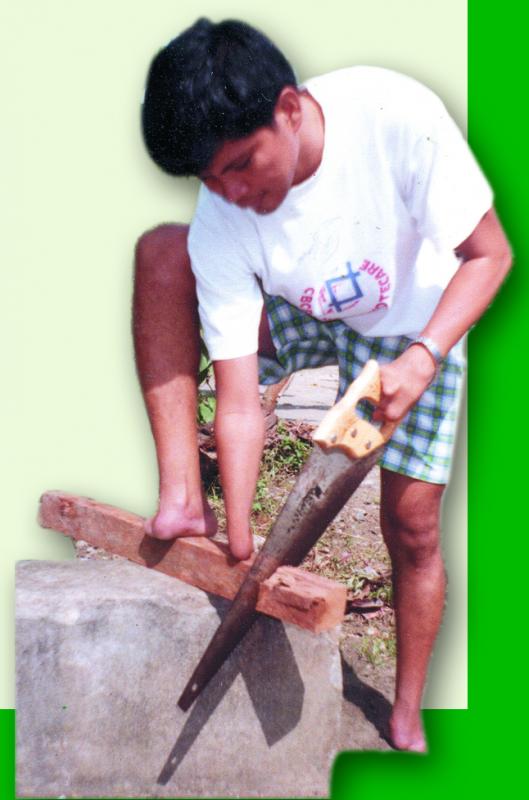
That thought was taking me along nicely until I caught sight of a youth in the front row waving his arms with as much energy as the rest. But something about his arms were different. He had no hands, I forget how I finished what I was saying.
He had neither hands nor feet, no hand at all on the right wrist, and only a partial palm on the left. This was Toto. Toto was brought up by a stepfather who regarded him as a cuckoo in the nest. Without a heath services or social security people like Toto have to rely entirely on the charity of others. Often their only recourse is to beg.
Toto manage to get through school. He was made of stern stuff and at some stage in his young life decided he wasn’t going to stay bottom of the pile. He started to help around the parish. In spite of his disability, Toto could manage hammer and chisel, and even screw driver. He took a course in drafting and mastered the subject. His next task was to find a placement in job-training. This proved impossible, through he tried hard. So he failed to obtain his diploma. He then developed a hacking cough, and T.B. was diagnosed. Fortunately it cleared up after treatment, but he still had no job.
While he was convalescing he made himself useful around the parish and it was then he got his first job offer. He was putting up parish notices when he was approached by a “businessman”. The businessman consisted of taking groups of blind and crippled people to major religious events where they could beg and tug at the heartstrings of the devotees. He offered to include Toto, and promised rich rewards. Toto refused, and lectured him on the shamefulness of profiting from others’ misfortune. So another ave-nue closed for Toto and, it has to be said, at least some of the time, beggars can be choosers. Still as they saying goes, when the Lord closes one door another will surely be opened. A college course offering teaching diplomas started in the area, and Toto signed up. He had no trouble with it, and so graduated.
Before any teaching post could be applied for the had to take the National Teacher’ Board Exam, and that was a few months away. Meanwhile he looked for a part-time job.
There was a vacancy in nearby parish high school. The parish priest put in a good word for him with the principal and so Toto presented himself at the school, only to be told that there was no vacancy after all. “I couldn’t let someone like that stand in front of the student,” the principal told the priest. So it looked as if another door had not only closed but slammed. Just then Toto announced his engagement to his longtime sweetheart, and they were married in due course. Bride and groom hung the rings on chains around each other’s necks.
Toto has now passed the Teachers Board exams and is going through the process of applications. If he has coped with handicap and prejudice and frustrations and still keeps his sense of humor and says his prayers, he must have a lot going for him. If nothing else, he is a challenge to our attitudes and faith.
Father Joeker

By Fr Joseph Panabang SVD
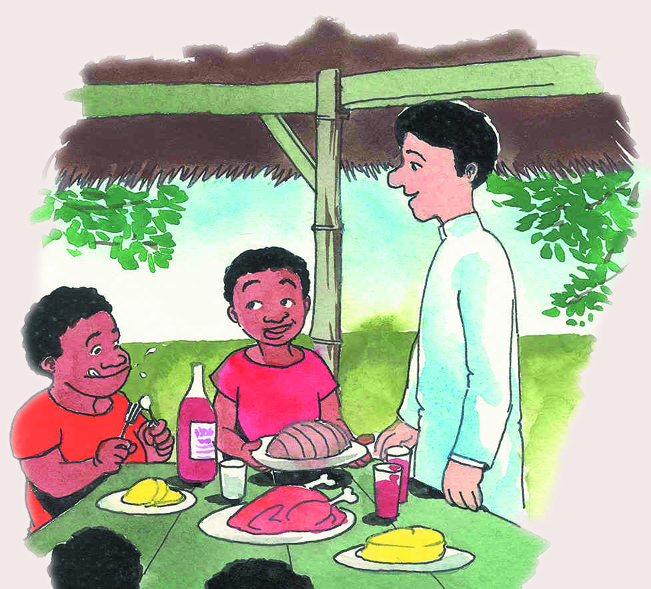
THE GLUTTONS
In one of the Wenchi villages, my altar boys and I were having our lunch. The food prepared by the catechist, seemed like a feast to me. I questioned the catechist, “Why did you cook so much?” “Father, your altar boys? I know them. I know their capacity,” she said with an emphatic smile.
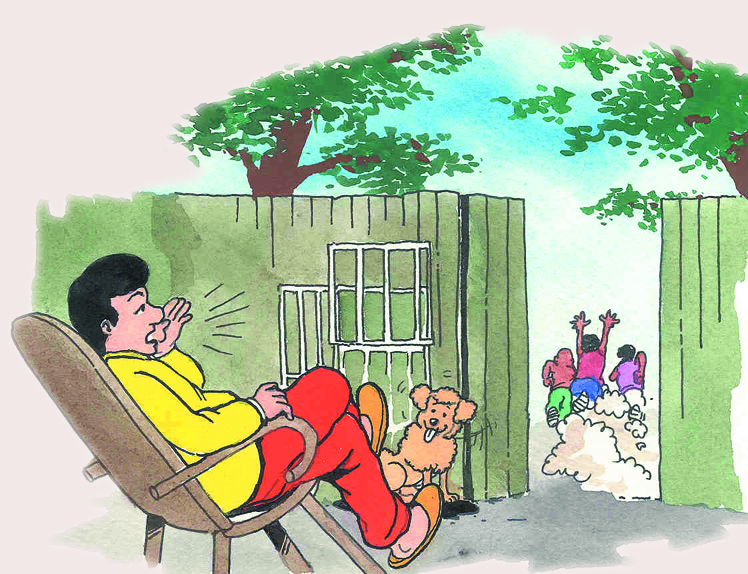
LET THE PUPPY ROAM
Every time I bring my lovely puppy out, children crowd around it very noisily. One time I was trying to relax but couldn’t because of them. I called out to my assistance and told her with my voice loud enough for the children to hear. “Bring the children into the cage and let the puppy roam around.” In a flash all the children were gone.
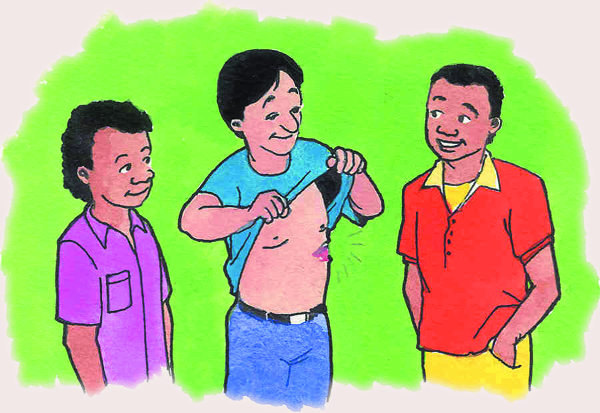
STIGMATA
One night in Soronoase village, while saying the Mass by candlelight, a strange insect hovering over the light fell onto my left rib. Frightened, I shook it off and accidentally squeezed it not knowing its pores cause itchiness. The whole week since that night, my left side was swollen and the wound became deeper and wider. Asked by a parishioner what was it I said, “This is my stigmata.” My fellow priests couldn’t hide their despairing smiles.
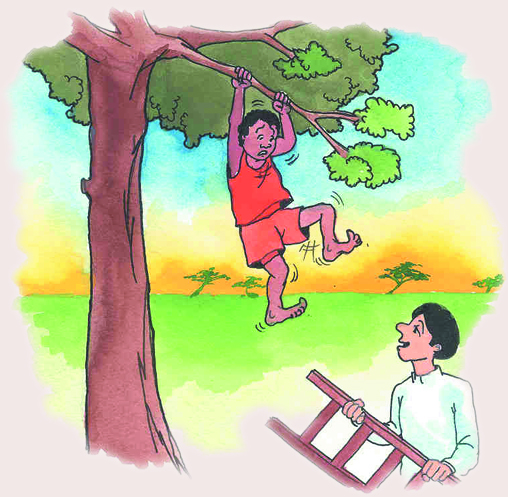
GREAT BARGAIN
Ali Jara, my assistant, went up the tree reluctantly using along ladder to cut off some twigs and branches. The last branch feel on the ladder knocking it down so that Jara was left hanging on for dear life to the ma to the main branch. He screamed for help but I though this time was a great opportunity for bargaining. “I will only put the ladder back from now on you will behave and will bathe the pigs without being told so!” “Yes, Father, yes, yes, yes...” After stammering one yes after another and before he would actually fall because of the violent nodding of his head, I finally returned the ladder much to his relief.
From Tribes Of Bukidnon To Korea
By Fr. Leo Distor mssc
I remember that I first wore a “sotana” and held a Bible close to my heart at age 10. That was in a school pageant performed in an elementary graduation ceremony. I was in the 5th grade then but I was asked to deliver the priest’s line making the young minds understand that priesthood is also a choice that one can make. I didn’t have a clue why I was asked to do that. Maybe the role was really not that popular among the graduating students that nobody among them played that role. I believe they would have rather imagined they’re a lawyer in a courtroom or working in the hospital or in school. I liked that role anyway. Now, if I’ll tell about my priestly vocation I would my priestly vocation I would say that the story should begin there.
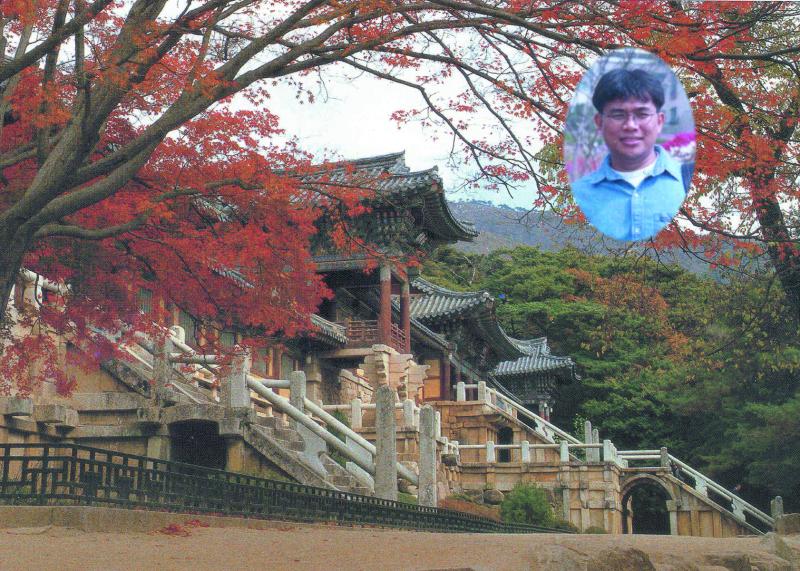
To do something else
As a child, I grew up watching regularly a priest saying the Mass on Sundays that after sometime I could already understand some of what he was saying. I saw many of them but I don’t remember specially liking any of them but I felt that I was a bit interested in what they were doing. Some people recognized this interest and suggested that I was suitable to be a priest. I had no problem with that. In fact it gave me something to think about. I did some search-ins in my high school and college days in the local seminaries and I was even invited to enter the seminary. But I decided to finish my college and work, through the seminary. But I decided to finish my college and work, though the thought about priesthood never went away.
Six years with the tribe people
I got this job in Sta. Cruz Mission, a mission for the tribal people, and I worked and lived with the tribal people, and I worked and lived with the tribal people for a good six years. I was first working in an elementary school then transferred to work was tough but interesting. It brought me many tribal communities around the province and gave me knowledge of the indigenous tribal religious practices. Some of the tribal communities were faraway and difficult to reach. I used a motorbike, a horse and walked many hours to visit the communities as a support to make religion program functional in those communities. In times when the priest went to celebrate the Eucharist with the community people. I went before him to prepare and assist at the Mass. In doing such work, I became more familiar in that area of the priest’s work. Those many of beautiful and meaningful experiences, sometimes really tough, prepared a rich ground for me in many ways to re-think my own plans for priestly life.
Being with the marginalized Filipino tribals opened a lot of doors for me. Understanding their “person” dancing to their music, singing their songs and struggling with them against the ‘beasts of prey’ surrounding them made me learn a lot and gave me enough spirit, depth and courage to move forward and heed the call of priesthood...and be a Columban. Fr. Sean McDonagh was close when I was making up my mind and deciding on which direction I should take. He played his part in this story.
Seminary Dilemma
Starting life in the seminary and doing exactly the same program with three other seminarians very much younger than me was not really a great situation...but, I should say, not the worst thing either. But things turned out favorably. The energy and the wit of my young companions really “woke” me up and pushed me to more work and prepared me to adapt more to the seminary life especially in continuing the Theology program with another group of younger people. In those formation years, I really had much struggle in learning and unlearning things. The sudden change in my dynamics from working independently and as an earner to the seminary structure with full time academic program and depending for all my needs on others again was hard on myself. I had moments then of thinking to go back home and work, but it was God’s wisdom that I saw my direction and came to understand those trying moment as hurdles to jump over.
First Mission Experience
I was sent to Korea for my First Mission Experience (FME). That was quite valuable for it really helped a not in my preparation for overseas mission. My time in Korea was fruitful. Korea is a rich and powerful in many areas, the Church has developed well and the society too and everything seemed to be really stable. With that, I was asking myself what sort of mission should newly arrived foreign missionaries do with the people apparently living a better life that us in the Philippines. Looking for some mission areas to work in after doing a few moths of language study was disorienting because there seemed to be nowhere to go and nothing to work on from the point of view of the social situation of the people.
Identity Conscious
But of course there was somewhere to go and something to do. I worked in two areas: a welfare center for the mentally handicapped and in a parish-based labor counseling office. I was accommodated in those areas not really because of their needs but rather they wanted to give me the experience was very significant to me. it did open me to the reality of mission in such an affluent society and a non-Christian country. The experience made me deal with my own resistance and biases about the new environment and culture and opened me to the better side of it. It also made me see my culture more deeply and appreciate it but some part of it I resented. I became conscious of my Filipino identity not only as a foreigner in Korea but as a Filipino Columban.
After my ordination to priesthood in Mindanao, I returned to Korea. As an ordained priest I had to take on more responsibilities and communicate more. That means learning the language again which until this time I’m still struggling with. Working in a Korean parish is a good venue in gaining knowledge about the dynamics of Korean Church. My first parish assignment was with another Columban but now I’m in another parish working with a Korean diocesan priest. Here is the real ground to experience the Korean Church, I am meeting people a lot – adults, youth, children – and this allows me to meet more Korean priest and be with my difference as a foreigner and as a missionary.
I was embarrassed
One thing about the Catholic Church in Korea; it enjoys a powerful status in the society and this implies power to the priest and to the church. People know their own places and keep their priest in their high places. Many Korean Catholics play an active role in the parish and, I would say, they work hard to live a good life. Sometimes I take pride when Koreans tell me how great the Philippines is as Catholics County, but one time I was embarrassed when someone asked, “How can crimes be so rampant in a Catholic Country like yours? Aren’t most of your leaders Catholics as well?” I could smile at it but it bothers me.
Indeed, things are really different in the way people understand religion, I hope my presence in the parish now will speak something. I’m enjoying my time and work here in Korea and I feel blessed. And this story goes on.
Mary As Every Woman
By Tina Beattie
A recent conference in Rome in ‘The Mystery of Mary’ surprised one Christian feminist who took part. Tina Beattie, who has written on Mary and lectures in Theology at Bristol University, found herself inspired by the wealth of the tradition.
Fourteen years ago, when I was living in Zimbabwe and exploring the possibility of becoming a Catholic, I told a priest that my two main difficulties were with the Pope and Mary. One Sunday morning, I found myself sweltering but jubilant on the steps of Saint Peter’s Basilica, where Pope John Paul II was celebrating Mass. This was the culmination of a conference on “The Mystery of Mary and the Trinity”, organized by the International Pontifical Marian Academy, to which I had been invited as a speaker. It has been a long journey from that time in Zimbabwe.
The conference brought together delegates from around the world, including participants from other complexity and vitality of Mary to the Catholic faith. But it also made me ask myself with renewed persistence: what is the significance of Mary in the modern Catholic world? Women formed a significant minority of conference participants. The ones I met were strong minded and highly educated, some with doctorates and licentiates in Theology, many of them were religious sisters living in ways which modern world. They include members of communities which minister to street children, prostitutes and drug addict, university lecturers and school teachers, artists and musicians, all women who are sculpting the contours of a future Church which is visionary, joyous and brave – qualities which surely epitomize Mary. But with few exceptions, these women were deeply suspicious of feminism. Doctrinally conservative and socially radical, they challenge some of my own ideas about the aspirations of women in the Church, and about the ways in which Mary both reflects and moulds those aspirations. There was much good-humored bantering about some clerical participants, and they were quick to criticize the boring rhetoric of some speakers, but it was refreshing for me to be among women who were happy with the Church, at peace with themselves, and able to laugh rather than rage at the foibles of the male hierarchy.
I also became aware of the chasm between the Mary beloved of millions of ordinary Catholics, and the Mary idealized and conceptualized by the men of the western theological tradition. The conference was held at the shrine of the Madonna del Divino Amore, outside Rome, where large new shrine and conference center have been built alongside a much older hilltop shrine, staying there brought home to me how vital Mary is to an incarnational theology which can be lived an not simply theorized about. It was a place where people were able to be themselves in the presence of an accessible and intimate God, irrespective of the theological abstractions about “divine generativity” and “Trinitarian processions” being propounded in the conference hall. There was a room decorated with family snapshots, sports trophies, racing bikes, photographs of mangled cars and glass cabinet full of crash helmets. All attesting to the Madonna’s capacity to embody God in every aspect of human life – death, Italian girls in skimpy skirts lit candles and crossed themselves, buxom mamas gossiped through the Mass to the accompaniment of chattering children, men came in lycra cycling shorts and business suits to offer their devo-tions; weddings, baptisms and funerals seemed to form a constant procession through the place, and families came by the carload to combine their prayers with a picnic and a day out.
I have come away from Rome with much to think about, but also with renewed respect for the enduring strength of traditional Catholicism. As a feminist theologian, I must continue to ask difficult questions about Mary in relation to Catholic doctrine and devotion. Some of what was said during the conference about Mary’s passivity, obedience and total and total surrender of self as the bride of Christ was troubling, because it was based upon an anachronistic view of marriage. There was something bizarre about the confidence with which many male speakers propounded their theories about Mary in theological concepts which seemed remote and irrelevant, not only to women’s lives but to any tangible human reality. But I have also come away feeling that I am part of a living body of faith which can accommodate all the abundance of the human family, women and men, young and old, of different races cultures and creeds, so much is did today about what’s right with it – and there is much to celebrate.
Salamat sa THE TABLET
No Longer Forgotten
In the awesome city of Hong Kong, glistening with the shine of the 21st century, live a small band of marginalized people who are mentally disabled. Sr. Leticia Bartolome, icm and her co-workers bring the news of God’s love to these sometimes forgotten people.

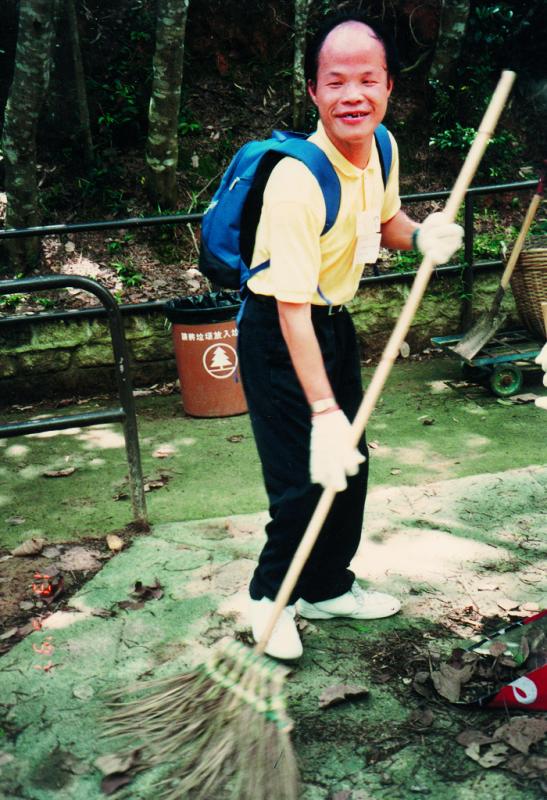

Savage Revenge
By Fr. Ramoncito Padilla sdb
I have been in East Timor for almost ten years now. When I arrived here in 1991, I remember that there were people, among them some of my Salesian confreres, who were saying that the greatest blessing this land had receive was to be integrated to the “great” Republic of Indonesia. It was easy to see why they said that. There were new roads, a lot of infrastructures that were being constructed especially in Dili, schools were being opened, government employees were being paid well, there was modernization. But as the years passed, it proved to me that these things were not enough. If the people were not happy because they are afraid, intimidated and oppressed, what was the use of all these things?

Right to be free
I was in the Parish of Venilale for six years, and I do not exaggerate when I say that every family has a story to tell about how loved ones were apprehended, tortured, killed or “disappeared”. Even after two prominent Timorese, Bishop Belo, SDB and Jose Ramos Horta, received the coveted Nobel Prize in 1996 and helped awaken the world on the terrible suffering of the East Timorese people, the Indonesian military continued to rain down more terror on the Timorese population. Bishop Belo described it as “even worse than before.” Yet, I have seen that even if the damage to East Timorese society as a result of more than two decades of Indonesian military occupation is so overwhelming, the East Timorese people have not given up something they cherish dearly in their hearts – their right to be free.
Not a tear
Everyone here, except the Indonesian Army and the pro-Indonesians, welcomed the news when President Habiebie said he desired that by January 2000 Indonesia should leave East Timor. Jose Ramos Horta “predicted” in a speech: “No tears will be shed by the Timorese people. When the Indonesians finally leave, they will leave behind a country thoroughly destroyed, a society profoundly traumatized by its 23-years savage colonization, a culture of violence, corruption and lies that used to be alien to the East Timorese traditional society prior to 1975.”
Casting ballots amid martial violence
The Timorese were supported to cast their ballots on the 8th of August, but the day for it was postponed for two or three times. Meanwhile, the Indonesian Military and the army-backed Militias continued to remain defiant and were bent on denying the people their hard won rights to choose their future; military goons pointed guns at children, machete-wielding hooligans terrorized the population and killed the unarmed, the army and the Indonesian police supplied the weapons for the violence and then joined in when no one was watching.
The day finally came to cast the ballot. It was the 30th of August 1999. In spite of intimidations and fear, the vast majority of the people went to the polling centers to accomplish their duty. The members of the United Nations Mission in East Timor assisted the people even if there numerous obstacles to a fair, democratic and transpa-rent consultation perpetrated by the Army and the Militias who were supposed to be responsible for creating a climate of peace and tranquility for the population, but were not.
78% for freedom
The outcome of the ballots was easy to predict. He 4th of September will always remain an important date in the history of Timor. The Secretary – General of the United Nations announced to the entire world the result of the Consultation Process. Seventy-eight percent of those who voted rejected the proposed special autonomy for East Timor, this leading the way to East Timor’s total separation from Indonesia. Before the Consultation, Indonesian President BJ Habiebie said, “If the people of East Timor decide for a separation we will do everything to make it happen in peace. We will separate in peace, in honor, as friends and we will live as neighbors and we will assist them within our capabilities.” Those were beautiful words.
The terror began
The very next day after the announcement, the world saw on their television screens how the militias and military started to sow terror among the people throughout the island – burning, lockings and killing, especially in Dili, the capital. And this continued for several days. Thousands of people-men, women and children – were abandon their homes and to Atambua, Kupang, Alor and other places against their will. The Military were ordered to leave Timor, and as they did so, the more they caused havoc.
Our Lady’s House
We continued to pray, and in spite of what was happening around, we Salesians, together with our novices, seminarians and students, decided to stay put and just do our ordinary duties. Our House is still alive. Two or three times we were threatened, but the militias never came. Some were saying it is because Fatumaca is Our Lady’s House – the Shrine of Mary Help of Christians is here - and because Pe. Alfonso Nacher, our nonagenarian who died a few months ago, has been interceding for us. I believe that is true.
Systematic elimination of leaders
We heard in the news that “there has been a systematic persecution of the leaders of the Catholic Church” by the Indonesian Army and the militias. In the Diocese of Dili there were four priests who were killed, and in the Diocese of Baucau, nine gave up their lives (Three deacons, two nuns three workers for the Church and one journalist). The fruit of their sacrifice is now beginning to surface.
Soldier from the Philippines
On the 11th of September, the news began to be a lot better. Several powerful nations promised to send as soon as possible their troops to keep order in the land and to stop the hostilities. On the 12th President Wahid, responding to international pressure, said that the government will allow peacekeeping forces to enter Timor, and at the same time gave authorization for humanitarian aid to be flown to many people who fled to the mountains and elsewhere. After a few days of waiting, which seemed like a thousands days, the international peace-keeping forces, headed by the Australians, did arrive. On the 26th of September, Sunday, I was so happy to meet our soldiers from the Philippines who arrived in our city of Baucau the day before. I have been saying the Sunday Masses for them since then, and have enjoyed speaking with them and teaching them the Timorese language, Tetum.
Viva Timor!
I am almost sure that East Timor will become the 183rd nation to take a seat in the United Nations. Then, all of us here will be able to shout unlike before, without any fear at all, without any fear at all, with all our hearts’ content: VIVA TIMOR VIVA TIMOR LESTE!
Shut Down The School Of The Americas
By Jane Sammon
The logo of the School of the Americas (SOA) is a circle which as its very center rights groups, SOA Watch, “the flagship of Christopher Columbus”, with a darkly sketched cross in the middle of its sail. On the other half of the circle’s border is the motto: Uno Para Todos y Todos Para Uno. Lastly, and surrounding all of this, are the flags of various Latin America and Caribbean nations, plus a rather discreetly positioned Stars and Stripes. One might assume it is there to indicate our unobtrusive role in this tidy arrangement, as “equal among equals,” a “one for all and all for one” camaraderie.

Tax resistance
So why would anyone want to end such hemispheric bonhomie? For a growing number of people, this is rhetorical. Many, although certainly not enough, have heard the dreadful data about the School of the Americas, a death squad pit-stop which has brought untold suffering to the folks back home. The Latin American and Caribbean officers sent there have been the beneficiaries of pleasant p perks-baseball tickets and theme park passes among them, and all, as the saying goes, “at the expense of the tax-payer.” As advocates of tax resistance, many of us here couldn’t think of a better reason to stop paying.
Cited for abuses
Thousands have attended the School – first, when located in Panama from which it left in 1984 for Fort Benning, Georgia (in Panama, it was known as the Army Caribbean School at Fort Gulick; there, since 1946). Graduates have been trained in counterinsurgency tactics, that of ten used euphemism for torture physical and mental; in sniper techniques, notorious “low intensity conflict” methods, to name but a few items in the curricula. Now, of these thousands, a disproportionately high number have been cited for human right abuses, implicated in massacres like El Mozote, Las Hojas, San Sebastian, el Junquillo, forming majorities of the participating officers in each case. Then, there are the more infamous, higher profile bloodbaths – the assassination of Archbishops Oscar Romero in March 1980, the rapes and murders of four US church women nearly nine months later, and the massacre of the six Jesuits, their housekeeper and her daughter in 1989. All of this in El Salvador alone!
In Columbia, over 100 of 246 officers cited for war crimes are its graduates. In Peru, nine university students and a professor were killed in 1994; three of the top officers involved, according to reports, were SOA trained. To be honest, the list goes appallingly on, one country to the next. Finally, and certainly most famous among graduates is our former friend and CIA employee, Manuel Noriega.
School of Assassins
In the wanting day of Lent, I joined a fast sponsored by SAO Watch on the steps of the Capitol in Washington DC to highlight the School’s disturbing practices to hope for its closing. The House bill of Congressman Joseph seeking that end has not yet been passed. His suggestion for a “school of Democracy” in its stead, would, for many of us, be no solution, knowing as we do, (and we think Mr. Kennedy does also) that US involvement is dubious and against the grain of other nations’ self-determination. Yet, the goodwill of the fasters, the genuine interest and often shocked responses by passers-by and tourist, on their way into one of our country’s renowned landmarks, on hearing the cruel facts of the SAO, made for fruitful dialogue. The resolve of many to go back to their communities and pass the word on about this “School of the Assassins” was encouraging. There were a few remarks which I heard that discredited the information at hand. I was especially moved by the presence of young folks who joined the fast, from cities as far away as Chicago and Dallas. These are the men and women written off as deadbeat, selfish “Generation Xers’ misery, with little compassion for others’. Recent arrivals to this kind of vigil, they were, nevertheless, emboldened in their new found work, of speaking the truth in a public manner, drawing attention to the ethos of raw power.
Passionate testimony
On November 16, 1995, the sixth anniversary of the massacre of the Jesuits and their friends, a group of mostly older men and women re-enacted the even on the ground of the SAO. Fr. Roy Bourgeois and companions, including 74-year-old Ursuline Sister Claire O’ Maria, from New Rochelle, NY, were sentenced to federal prison for terms ranging from two to six months. Since Fr. Roy has been before Judge J, Robert Elliot on two previous occasions, he received the longest sentenced. But, in a phone conversation a few days later, his good spirit was intact, his joy, irrepressible. He felt that the judge, whose animus toward those doing this sort of demonstrating is well-known, had changed; that his heart was touched, particularly by the clear and passionate testimonies of Sr. Claire and, mother of eight Jo Anne Lingle. It is said that Fr. William Bichsel, 67, sentenced to four months, invited Judge Elliot to join them some day, in getting the SAO closed. Young and old alike, are all in need of conversion, in bearing witness to the truth.
Salamat sa The Catholic Worker
The Hermit Kingdom
By Gee-Gee O. Torres

Three and a half hours after the plane left Manila, I was already at Kimpo International Airport in Seoul, capital city of South Korea. Juliet Bacamante, one of our Filipino Columban lay missionaries, met me at the airport. Juliet said we would take the subway from the airport going to the Columban Central House where I would be staying. I was excited. This was my first time to take an underground train. We walked down several flights of stairs. I wondered where we were heading. We seemed to be getting down and down below the ground. Finally we came to a halt in a tunnel with rail tracks. Juliet said, “We’ll wait for...” and before she could finish her sentence a train charged into the station and stopped breathlessly. She dragged me along and we rushed among the many passengers waiting fro the train. I was like back in Manila at the LRT Station, inching my way to get into one of the carriages before the doors snapped closed.
A glimpse of Korea on the subway
The subway trip from Kimpo Airport to the Columban House took almost one hour and a half. But I enjoyed the ride so much that I didn’t notice the time, I was preoccupied watching the people in the train listening to Juliet as she briefed me with eh dos and don’ts in Korea. Unlike in my previous trips, whir I felt at home with the people right away, the Korean people seemed to be indifferent. They all looked seriously, so quiet that it seemed and Juliet and I were the only ones talking in the train. And the far end of the train I saw an old man dozing off, but the young man sitting beside him looked as if unaware of the old man. He was engrossed listening to his walkman. Then another passenger caught my attention. She was dressed in mini-skirt & body-fit shirt, with heavy make up and her hair was rainbow colors. And I noticed a young student giving her seat to an old woman. I could see the new generation caught between tradition and modernization. I wondered how do the old people cope with the fast-changing society in Korea?
Cup of Tea
It was almost eleven o’clock in the evening when we got to the Columban House. I was glad that despite arriving at an unholy hour, I got warm welcome from the Columban Fathers and, of course, the irish hospitality of “Would you like to have a cup of tea?” But since it was almost midnight I politely declined the cup of tea. So Fr. Denis Monaghan, the bursar, showed me to my room and we said goodnight.
My survival kit
The next day Juliet came over to see me. She wanted to make sure that that I was ready for my Misyon assignment. She gave me my survival kit – complete with telephone card, bus card, subway ticket and map, list of phone numbers. I survived my first day and found my back to the Columban House. After a few days of taking the subway, not to mention having waited for two hours at the wrong station for Juliet, I finally mastered the art of taking the subway. Now i was ready to go on my own and track down our Filipino missionaries. They were mostly assigned in Seoul so it was not too difficult to find their ‘hideouts’ for most places in Seoul are accessible by subway. There were times when I took the bus, but always wit ha companion; I wasn’t that confident riding the bus by myself. It was easier to take the subway for I knew exactly where to get off. (Thanks to Korean Government for putting up English translations of the names of the subway stations when they hosted the Olympics Games in 1988.) In a bus it was a bit complicated. Every street looked the same to me high-rise buildings, stores bearing Korean characters which I couldn’t possibly read, sidewalk vendors selling all sorts of products-from chopsticks to Kimchi to the latest fashion wear in town.
The Church in Korea
The history of Christianity in Korea is most interesting. It wasn’t brought about by foreign missionaries like in the Philippines when the Spaniards came. It was started by some lay people who went to China as scholars to study. There they met Jesuit missionaries and fell in love with the faith. And when they came back they started a praying Catholic community. So in the eighteen hundred when the first foreign priest arrived in Korea, he was amazed to find four thousands Catholics already baptized and awaiting his instruction. Not only is this unique in the history of Catholic foreign missions but is also source of pride to Korean believers.
The Korean Church is traditional and somewhat conservative. When you attend a Korean Mass you will still find many women wearing veils. And priests do not go round in casual clothes like here in the Philippines, but they all wear Roman collars. At Mass the people participate vigorously. They answer loudly and clearly and sing in very strong voices and, of course, everyone dresses up. I noticed they have a “cry room” where the children can be looked after during Mass. The children are visible through the glass wall and their guardians can follow Mass. At the offertory the whole congregation lines up to leave their offering in a basket in front of the altar and communion is very formal and solemn. Though Catholics in South Korea are a minority – 7% of the total population of 47 million – they are proud to be called Catholics. In the North, I am sure our fellow Catholics feel the same way, too.
Columban Fathers and their role
The Columban Fathers played a big role in the Korean Catholic Church. They came to Korea in 1933 when the first group of ten priests took charge of the mission territory in the southwest of Korea. During that time there were only six Korean priests in the area. In the early yeas there was a lot of harassment by the Japanese, who were occupying Korea, and when World War II broke out in 1945, missionary activities were suspended. All foreign missionaries, including the Columban Fathers, were expelled, placed under house arrest or imprisoned by the Japanese. With the coming of the Korean War in 1950, which is the cause of the division of Korea, once again the people and the priests suffered. Seven Columban Fathers lost their lives in this war.
In the 80s and 90s there has been a huge increase in the number of Korean priests. It was now time for the Columban Fathers to turn over their parishes to the Diocese. So from parish work the Columban now branched out into other apostolates such as counseling, hospitals chaplaincy. Justice & Peace, migrant workers and mission awareness. In 1984 the Columban Society also started their own formation program and accepted local vocations in Korea. Five years later they began to recruit lay missionaries, some of whom are here in the Philippines today. The Columbans may not vein as many parishes now as before but their work is far from over. They are into a new kind of missions: helping the Church in Korea itself become more missionary.
Once the Hermit Kingdom
Though the Korean Church is traditional and somewhat conservative, its is gradually opening its doors to the outside world. They have welcomed foreign missionaries like the Columban Fathers to come in and at the same time Korean Missionaries abroad. The land once called the Hermit Kingdom, I believe, is the beginning to come out of its shell and share its richness with the world.
The Long Struggle
By Fr. Victor Dinangan cicm
Father Victor Dinangan, cicm is a native of the Philippines. He was ordained priest on April 10, 1999 in Tierra Nueva, Guatemala City. Before his ordination he spent a couple of years as a missionary intern in Guatemala. The following article relates some experiences he has at that time, specifically with the Community of People in Resistance.
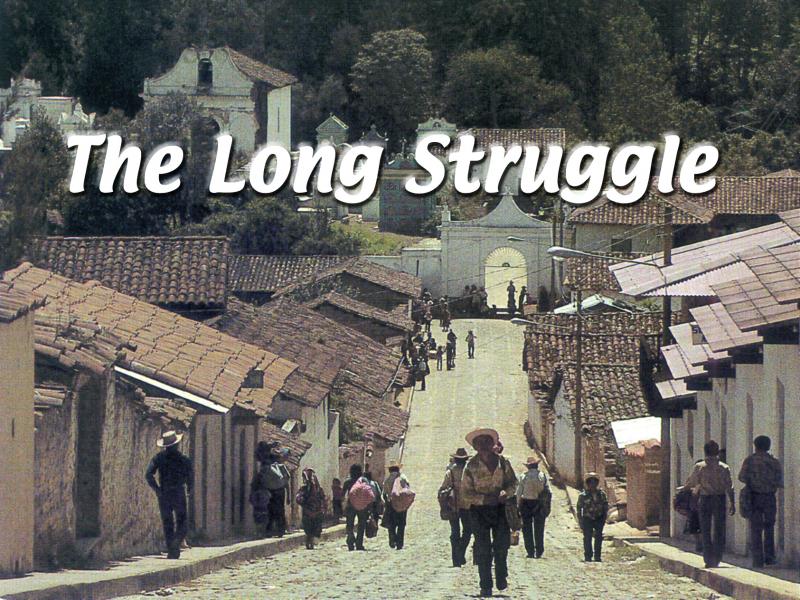
An important dimension of my program as an intern in Guatemala was to obtain a better knowledge of the history of the people. I expressed a desire to get to know the CPR (Community of People in Resistance). I wanted to just go and live among them and listen to their stories.
The CPR started as a response to the military repression that swept all over Guatemala from the 70’s up until 90’s. The majority of these who went into hiding in the mountains did so avoid the abusive and violent control of the military. They had heard of the cruelty of the soldiers and their strategy of using innocent villagers to persecute, torture, and kill their co-villager. Opposing such military orders meant death.
On December 29, 1996 the signing of peace agreement ended the military operations in the area. Part of the agreement was the resettlement of all those displaced by the war. One community of 350 families was resettlement of all those displaced by the war. One community of 350 families was resettled on the farm estate of El Triunfo. It is in this community that I learned about CPR experiences, by just participating in the daily life of the people and by listening to their stories.
Testimony of Ramos Sica Family
Apolonia is 48 years old and married to the late Santiago Baten 27 years ago. They where both natives of Las Mejada, Aguatacan, Huehuete-nango. Guatemala. They were blessed with two children; Pedro who is now 26 and Antonio who is 19.
In 1978 the so-called military repression started. There were lost of killing, massacres, disappearances of people and burning of houses in the villages. The people of Las Mejada heard that the military was getting more violent and that they were penetrating the most interior parts of the province. But because there village was quite far from the town proper, they did not expected the military to reach their village.
Military Violence
One day, in February 1982, Santiago was working in the cornfield. Pedro, then ten years old, was pasturing goats and Antonio, three years old, was sleeping inside their house. Apolonia was cleaning the backyard. All of a sudden, Apolonia heard gun shots. She knew that the military were coming but thought that they were still a distance away. Se went to fetch Pedro and while they were on their way home they saw their house was on fire. She thought that Antonio is burning inside the house, but she could no longer get any closer because the soldiers would have killed her.
Later she said, “We owe a lot of thanks to our neighbor who was brave enough to take my son from the house. He carried him on his shoulder and ran away while the military were firing them. He really saved my son.” She added, “Since the community was dispersed, we had to look for one another and regroup. We went to hide into the thick mountainous forest.” As they penetrated deeper into the mountains, looking for a better and safer place, they met other communities who had left their villages due to the same error.
Friend, spy and traitor
In December of 1984 they arrived at Santa Clara, were the villagers kindly accepted them. They lived peacefully in this place for two years as the military lessened their offensive operations.
On January 5, 1987 some men volunteered to go back toothier place of origin and nearby villages to buy salt. sugar, clothing, medicine. Mr. Santiago Baten was one of these volunteers. Eye witnesses, his companions who later told the story to Apolonia, said that when they arrived at the village Mr. Santiago established contact with a most trusted friend and neighbor. Unfortunately, Santiago did not realize that his friend was a military spy and traitor. His friend set him up, and even made false accusations. While they were talking, the military and their civilian arm known as PAC (Patrulla Auto-Defensa Civil) came in. They arrested Santiago, tortured and finally killed him on January 15, 1987. Nobody knows companions were able to escape from the scene and manage to return to the community.
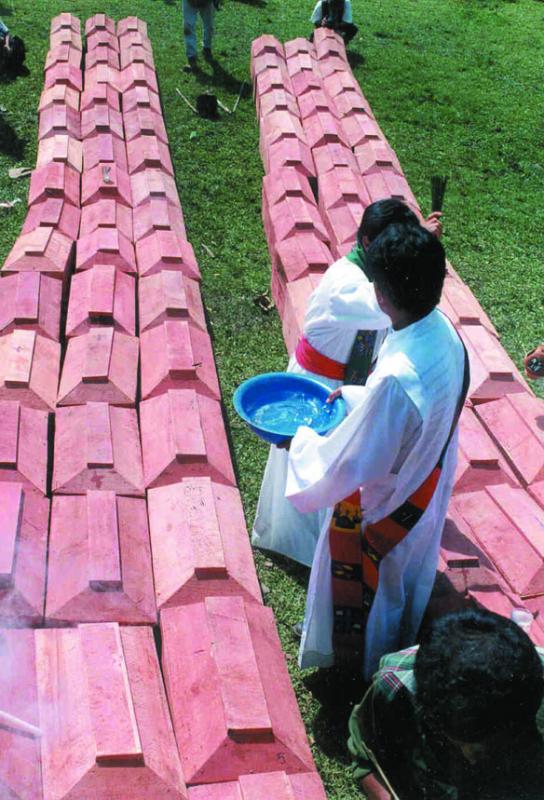
Hide-and-Seek
During the years 1987 to 1990 the military intensified their offensive. Their were more bombings, burnings of houses, destruction of plants and killing of animals. All that the community had built up in two years was destroyed. The Baten family and their community played hide-and-seek with the military. When the military was not present, they planted whatever they could. Then the military would return and born down all the fields. During those four years Apolonia did her cooking midnight so that the military would not be able to see the smoke of her fire.
Peace Agreements Signed
In 1991 some members of the community risked their lives to sneak into the city and contact some Church leaders of local and international organization. This led to a massive campaign for public recognition of 3, 000 families as CPR. All this, and mediation by other organization, enabled the CPR families to come out form thier mountain hiding places and to settle in three communities of Santa Clara, Xeputul and Cabaj. The military still tried to isolate them and prevent them from selling their produce.
Finally, the military oppression came to an end with the singing of the Peace Agreements in 1996. At last the families of CPR were given access to any town or village.
My work with them
The struggle still continues to day. In the words of Sister Lynn Leuterio, icm, the CPR people “...continue to build a new identity... the greater value of life and solidarity.”
As a missionary intern I am obliged to know their conditions, to feel with them and to be in solidarity with them. I opted to accompany the CPR people and though their unforgettable experience cannot be set aside, I felt them journey from that terrible past toward a new life. Despite being uprooted and replanted twice, they remain determined to keep on struggling.
My deepest gratitude goes to this community; to the families who accepted me and had the confidence to share their experiences with me. Surely their history will be kept and always remembered in my journey as a CICM missionary.
To Search is to Find

 For some time we have been asked to put in Misyon a section on questions which our readers would like raised. We are not too sure how appropriate or suitable this is, so please let us know if these questions have been of any help to you. We are calling this article To Search is To Findbecause we do not have the answers to every question – but the very asking of the question is the beginning of the answer.
For some time we have been asked to put in Misyon a section on questions which our readers would like raised. We are not too sure how appropriate or suitable this is, so please let us know if these questions have been of any help to you. We are calling this article To Search is To Findbecause we do not have the answers to every question – but the very asking of the question is the beginning of the answer.
SEPARATION OF CHURCH AND STATE
Is there not separation between Church and State in the Philippines? How come the Church in the Philippines seems to be interesting in State matters?
Answer: The bishops of the Philippines have spoken out on the 1995 mining laws, on the Visiting Forces Agreement, on the Cha-Cha, on gambling, on the death penalty and on general corruption in the government and on the environment. These questions are all in the domain of the government but they also are moral questions and the Church should speak out on them. But the Church should not interfere in party politics or involve itself in campaigning for elections. That is the job of ordinary Christians. The Church should try to enlighten Christians and then leave them do their job.
TWO COMMUNIONS IN A DAY
Can I receive communion twice in the same day?
Answer: Strictly speaking, no. but if you have a special reason like a wedding or a funeral, or some special family occasion an exception can made.
SECULAR AND RELIGIOUS PRIEST
What is the difference between a secular and religious priest?
Answer: A secular priest is under the bishop in a diocese and does not change from that diocese. The bishop is his spiritual father. The religious priest belongs to a spiritual family like the Jesuits, Dominicans, Franciscans, Recoletos, and the superior father figure. The member can be moved to wherever the order is working.
DEATH PENALTY
Why is the Church so strong about the death penalty?
Answer: The Church teaches that life is sacred from the womb to the tomb. If she was not strong about the death penalty, her voice against abortion would not be taken so seriously.
SUPPORTING PARENTS
I would like to become a missionary priest but that would mean leaving home and not being able to support my parents. Is there any way around?
Answer: No. Your obligation to support your parents comes first; nor should you become a priest in order to support your parents. One can only become a priest when you have already fulfilled your obligations to your family or you are sure that there are those who will fulfill them. But frank discussion should be had with other siblings so that one person is not left to look after the parents while the others just do their thing. Read Mark 17:11 where Jesus reminds us of our obligations to support our parents.
PRIEST DID NOT SAY MASS
How come the Church is taking the side of the Muslims in Mindanao? We Christians have been here for hundreds of years. We don’t want to be turned into an Islamic state. It seems we’re not getting the sympathy and support from our pastors that we should expect. One priest refused to say Mass for the soldiers.
Answer: The Church is not in favor of Mindanao becoming an Islamic state or even of it being taken over by the Muslims but it does stand for human rights for Muslims who are being harassed and oppressed by some Christian soldiers. It is precisely this treatment of the Muslim population which pushes them toward dreams of an Islamic state. The Ordinary Muslim-Filipino wants a peaceful life for the chance to practice his religion without being discriminated against.
Yes, I read of that priest who refused to say Mass for the soldiers in a military camp in Mindanao. The soldiers also have souls. In fact they need a priest's ministries more than anybody else. It seems wrong to refuse them. But in this case the soldiers were in the middle of military campaign. The district was filled with Muslim refugees who had lost their homes because of Christian soldiers. Bringing in the local priest to say Mass at that time would have sent the wrong message to everybody. It would be almost like blessing the atrocities done by the military at that time. The soldiers actually have their own chaplains especially salaried and detailed for that work. Inviting a local priest in seemed more of a military strategy than a religious action. The priest was right to refuse.
HIDDEN TABERNACLE
When you come in to our church you cannot see the Tabernacle. It’s hidden away in a little oratory at the side. I miss it. I think it makes the church less holy.
Answer: A discreet side chapel gives great reverence to the Blessed Sacrament but according to the law of the Church, the Tabernacle should not be hidden away. It should be in visual and special relationship to the altar so that people can see that the Blessed Sacrament is the fruit of the Sacrifice of the Mass. In a small church or chapel it is better to leave the Tabernacle behind the Altar. In a large church it should be to the side but clearly visible and attractive.
NO COMMUNION FOR UNMARRIED PARTNERS?
I was at Mass in Korea when the Pinoy priest said to a Filipino congregation at the homily that those who are living-in with a partner without the benefit of marriage should not go to Communion. What do you say about this?
Answer: That priest was correct. That is the teaching of the Church. Those couples should break their liaison and confess before going to Communion. Communion received devoutly will strengthen them against temptation and help them to remain faithful to the partners they have left behind in the Philippines. In fact overseas workers need all the help they can get as indeed they too would wish their partners at home to remain faithful to them.
CONFESSION
How often should I go to confession?
Answer: Strictly speaking you only need to go when in grave sin. Confession is also a support in our search for holiness and for God and for overcoming our habitual faults. So confession at Christmas, Easter and on your birthday is a good idea.